Goodbye to the Greater Flamingos!
There's a big change to the flamingo collection at WWT Slimbridge Wetland Centre. The large flock of greater flamingos has vacated the “Flamingo Lagoon” exhibit. Greater flamingos have been resident at WWT Slimbridge since the “Severn Wildfowl Trust’s” first flamingo flocks were established in the 1960s. Over the years, these flocks at Slimbridge have grown and now, with our increased understanding of animal management techniques, animal welfare, and the impacts of captive animals on the environment around them, it has been time to rationalise these flamingo populations.
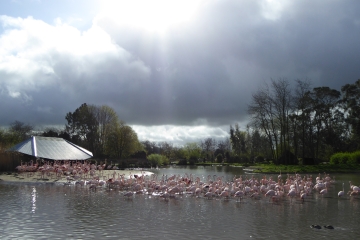
Discussion and eventual action on how to best manage the flamingo populations at WWT Slimbridge has been taking place for a number of years. Our wonderful group of Andean and lesser flamingos are far too old and zoologically valuable to rehome, and our Chilean and Caribbean flamingos are important from a conservation and population sustainability perspective. The greater flamingo is becoming a common wild bird, its population is growing, and its range is expanding. It is also a familiar inhabitant of many zoological collections around the world. Therefore, this species was the ideal candidate to move on.
We can still say, for the moment at least, that WWT Slimbridge is home to all six species of flamingo as we have kept a small number of greater flamingos that were not deemed fit for travel. This change to our flamingo populations is in the best interests of the remaining flocks, improving their housing, management, and welfare.
Sir Peter Scott first acquired greater flamingos from Lake Nakuru in 1961. These birds joined the existing collection of ducks, geese, and swans at the wildfowl trust at Slimbridge, along with Chilean and lesser flamingos. Peter Scott believed that flamingos were close relatives of the ducks, geese, and swans - hence why he wanted to exhibit these wonderful pink birds in his wildfowl collection. We now know that flamingos are not related to the ducks, geese, and swans but we still keep them at WWT because they are our best ambassadors for the wonder, diversity and variety of life we find in wetlands. Our flamingos are firm favourites with our visitors.
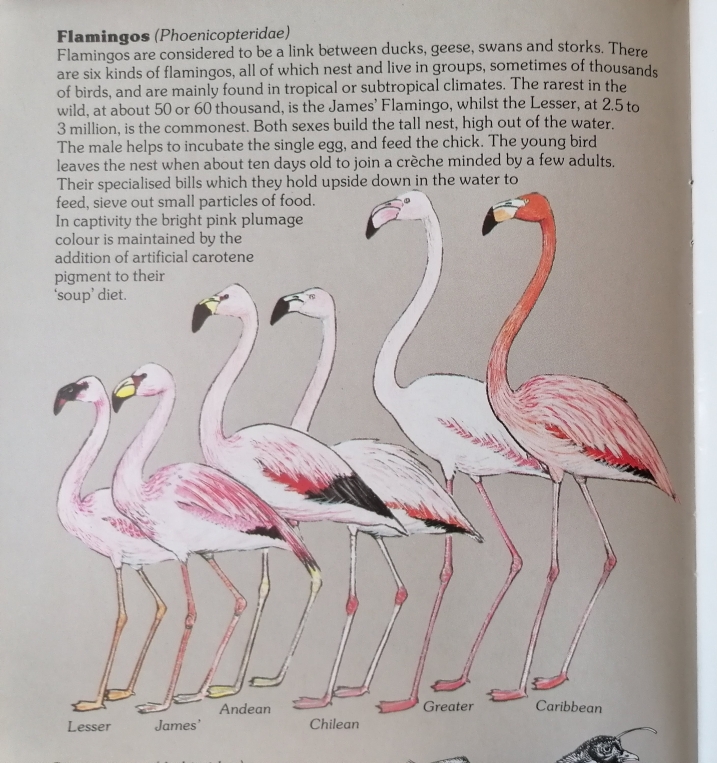
A diagram from an old guide to "The Wildfowl Trust" that describes why Sir Peter Scott wished to give a home to all six flamingo species.
The greater flamingo is a very successful bird because it is more generalised in its dietary requirements and choice of habitat compared to other species. Being more generalist has allowed the greater Flamingo to exist in a wider range of wetlands, often alongside of human populations, when compared to the other species of flamingo. The Chilean flamingo for example has a declining wild population and is threatened by human activities around its wetland habitats. This more specialist flamingo is less able to cope with human presence. And the crimson Caribbean flamingo is restricted in its range to a small number of places in central and South America, therefore captive populations of this species (and for the Chilean Flamingo too) are essential to conservation and population management.
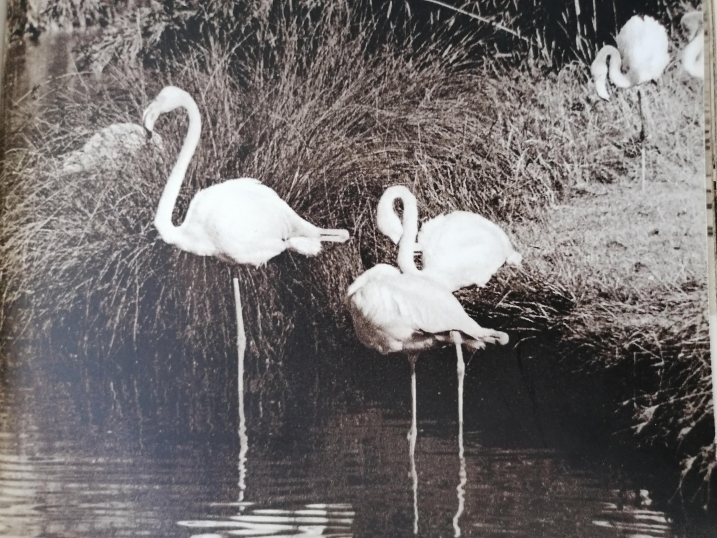
Original pioneers. A photo from the annual report of The Wildfowl Trust in 1962 that shows the first greater flamingos to live at Slimbridge who arrived in 1961.
So whilst the departure of our loud and large greater flamingo flock is tinged with sadness, we know we have done the right thing for our other birds. Our resources will be better utilised, and our flamingos will be more in line with the conservation needs of these species in zoos and in the wild.
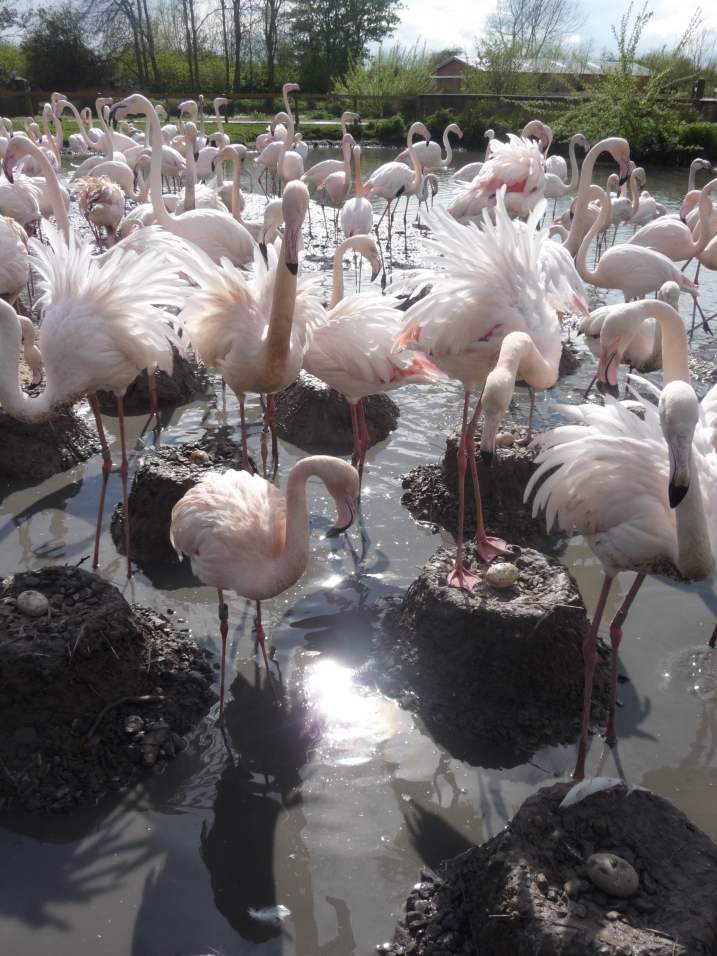
A throwback to 2012, and the greater flamingo flock breeding in the enclosure that now houses our Caribbean flamingos. You can see the Flamingo Lagoon exhibit being developed in the background.
We are extraordinarily lucky at Slimbridge to house large flocks of flamingos. Flamingos are incredibly social birds they have evolved to live in large groups. Therefore, for their welfare large groups are best. But not all zoos can do this, so we know that our flamingos are contented flamingos because we give them lots of social choice. But these large groups require complex planning to meet the logistical challenges of moving birds in big numbers. For this Flamingo Diary I spoke to Phoebe Vaughan, Deputy Living Collections Manager at Slimbridge and I asked her about the practicalities and on the ground management of a Flamingo move on this scale.
How did you plan and organise the move?
Phoebe explained that coordination and communication, and building relationships between other organisations that are similar to WWT (e.g., other bird collections and wildlife parks) is essential in helping with this type of animal management need. Phoebe and the Living Collections team at WWT Slimbridge worked hard to ensure that everybody involved in the move knew their job role, knew what they were going to do, and all equipment and facilities used for transporting birds were up to scratch. This would all ensure the comfort and well-being of the animals. This undertaking was a long time in the planning and processing! But that was all for the birds welfare.
What will happen next in Flamingo Lagoon?
Phoebe explained that we will move flamingo flocks around so that there will still be a great visitor experience at WWT Slimbridge that involves large groups of flamingos. Flamingo Lagoon will be repurposed and renovated over the winter in time for new developments in the spring that focus on our beautiful flock of Chilean flamingos. Whilst the greater flamingos may have gone from the Lagoon, there will still be a flamingo experience that shows these birds in the large social groups that they have evolved to live in. And don't worry you'll still be able to see greater flamingos at Slimbridge because we will still have some of our older birds living on site.
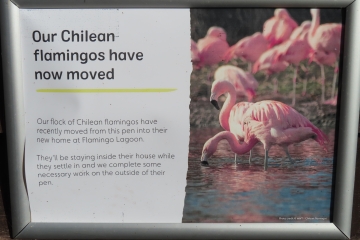
And I also spoke to one of our expert veterinary surgeons, Dr Michelle O’Brien, who had the role of ensuring good bird welfare during this mammoth flamingo move. Regular Slimbridge visitors, WildWatch viewers, and those that keep up with the Flamingo Diary will know that some of these birds are aged, veterans from Peter Scott's original flock. It was Michelle's job to check that everyone was fit to travel. So I asked her “what does a healthy Flamingo look like?”
How do you move a flamingo safely?
Michelle explains that health checking of flamingos is really important before and during a flamingo catch. The birds’ legs, wings, heart rate, and breathing, as well as their overall body condition are all assessed by the vets. Here at WWT we have a standardised protocol for flamingo health checking which is particularly important during moves and catches and we assess all birds alongside of this standard protocol. Michelle and the rest of the veterinary team are experts in promoting and protecting the health and well-being of the flamingos, and indeed of all of WWT's animals, so by following a method that is employed on every bird and checking the same vital signs on each animal, we can be sure that we are transporting healthy animals that will be fit to go on the journey. Only when a flamingo has been assessed and given the “OK” by the vets would be ready to leave for its new home.
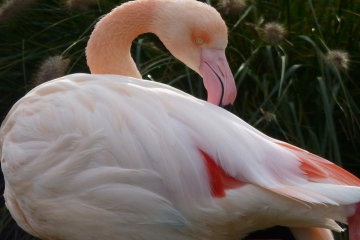
A greater flamingo that is estimated to have been collected in 1956. Flamingos live for a long time. Considering the health and wellbeing of older birds is essential when they may be moved or handled.
Over the year's the WWT Slimbridge greater flamingos have taught us a lot about flamingo biology and behaviour. We have used them in many pieces of observational research. To understand the strength of flamingo friendships - do flamingo choose specific partners to spend their time with in and out of the breeding season? To understand the full 24hour day of the flamingo - what do they do when their keepers and WWT visitors go home in the evening? And to help us understand how a flamingo flock uses the space that it is provided with - what do they need to keep them happy and contented under human care?
So it’s farewell to the greater flamingos for now, but rest assured that more exciting flamingo flamboyances will be occurring in the near future!



